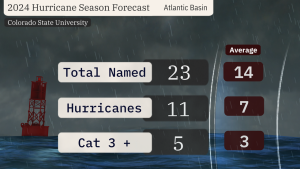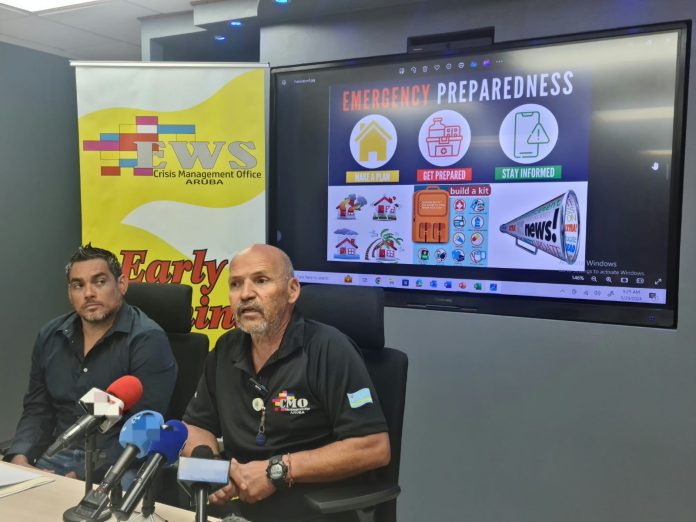The hurricane season is set to begin on June 1 and end on November 30. For this reason, yesterday morning, during a conference between Meteo Aruba and the Crisis Management Office (CMO), it was announced that this year will see a very active hurricane season according to reports from the National Hurricane Center and Colorado State University (CSU Tropical Weather & Climate Research).

Rodney Tromp from Meteo Aruba indicated that Colorado State published a report last month indicating that the hurricane season is expected to have a higher-than-average number of Named Storms, with an average of 14.4 storms where the season typically sees 23. For hurricanes, the average for this year is projected to be 7.2, with 11 hurricanes expected for 2024. Additionally, five major hurricanes are anticipated, and the days of Named Storms for 2024 are expected to be 115, which means “this year will see a very active hurricane season in the Caribbean, the Atlantic, and the region,” Tromp assured.
Meteo Aruba monitors this data daily, with an eight-person team responsible for sending alerts “appropriately” to the community, ensuring they are informed and know what to do together with the CMO to guarantee the island’s safety during this hurricane season.
Currently, sea temperatures in the region are quite warm, and they are considered to be “at the normal level,” which means there is a lot of energy in the region. Tromp also commented that the El Niño phenomenon, a climatic event related to the warming of the Pacific Ocean, will switch to the La Niña phenomenon, characterized by cooling the surface waters of the central and eastern Pacific, which is favorable for hurricane formation, according to Tromp.
On the other hand, Tromp noted that they are working on a plan and if there is a threat, they will activate the plan immediately. He also mentioned that the situation in Aruba and Curaçao is different because Aruba’s winds are stronger. “Curaçao has its local effects, and Aruba has its local effects. There are forecasts for the day and night, but during the hurricane season, when there is a threat, all (ABC) islands must coordinate with the Netherlands and the National Hurricane Center to issue a warning together.”
Rino Geerman from CMO explained that it is expected that this year’s hurricane season will be more active in the Caribbean region, with a higher probability of systems entering the Caribbean compared to previous years, which were kept out of the Caribbean due to the effects of La Niña, predicting an 85% increase in hurricane activity.
Aruba’s biggest problem is rain, not wind, according to Geerman. History shows that out of 10 hurricanes, 8 are rain-related. “We started preparing for hurricanes after March 18, and we have dealt with the Netherlands to ensure Aruba is not left alone at the Kingdom level where various instances have already met.”
Regarding how they alert Aruba, Meteo Aruba, Meteo Curaçao, and the Hurricane Center will have a meeting before issuing a warning. “It is good to inform the community that as soon as a system reaches Barbados, the process will be activated, or 120 hours before we start the legal process of asking the prime minister for permission to put Aruba on alert, prepare our departments, and potentially inform the public 48 hours before the system passes over or near Aruba,” Geerman said.
In 2024, they will try to ensure the community does not panic when they see a red flag on the internet. “Meteo is responsible for informing CMO, and we are not the same as Curaçao or Miami. Miami gives recommendations based on their expertise but cannot put Aruba on warning. Neither can Meteo Aruba. CMO, together with Crisis, Government, and the council of ministers, makes the decision to put Aruba on warning and determine the steps we will take,” Geerman pointed out.
By August, all current dilemmas will be resolved when the Early Warning System is installed in Aruba, providing information in four languages, as Geerman indicated.
“For those whose roofs are leaking, I recommend checking them carefully because this year will have a lot of rain. For those living in areas known to flood, be aware that this year will be more troublesome. During bad weather starting early in the morning, consider if schools will be closed and at what time,” Geerman commented.
He also informed that by today, Friday May 31st, the CMO, responsible not only for Aruba but also for the Dutch Kingdom, needs to prepare Sint Maarten, which is in the hottest hurricane zone, in case something happens there or in other islands north of Aruba, they can accommodate victims.
Regarding tourism, Geerman assured that ATA is part of the crisis team and receives all information. He confirmed that historically there has not been a direct impact on Aruba, but the problem is rain, which could start in June or July, saturating the ground and causing flooding in August with subsequent rains.
Given that different areas will be affected by the rains, Geerman said Aruba does not have large pumps and they will arrive in August at Marinierskazerne, “but again, Aruba needs to start thinking and it’s time for us to start buying our own pumps.”
When asked about the difference between previous hurricane seasons and this one, Geerman confirmed that during a full year, Aruba receives 300 millimeters of rain. This season, it is expected to be double, “meaning we need to prepare for 600 millimeters of rain.”
All information from CMO or Meteo will be published in the local Aruba press.
















